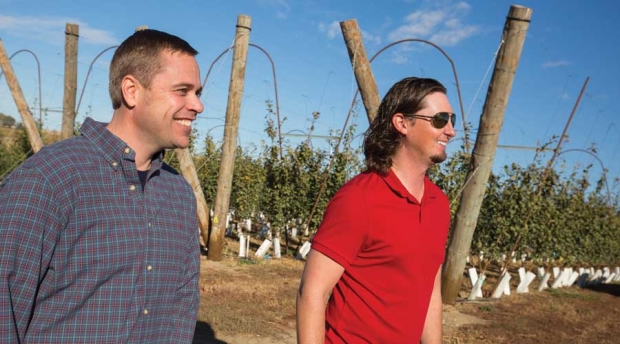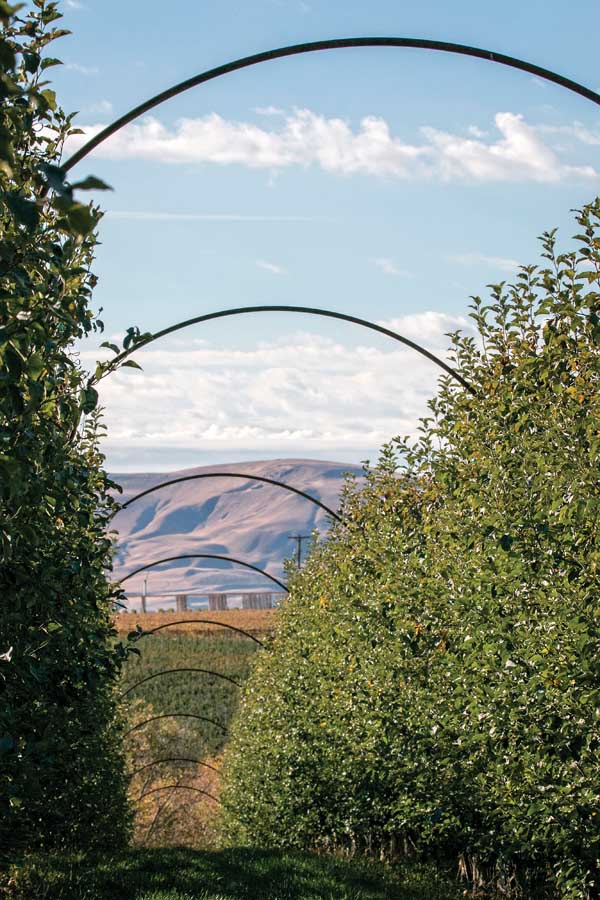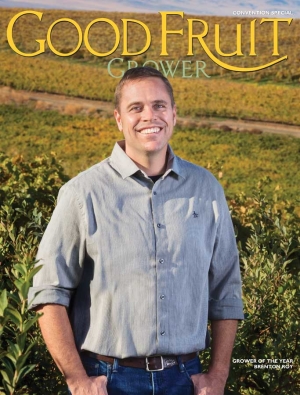
Brenton Roy and Derek Hill walk next to a newly planted block of apples. The large end posts were taken from hops fields. (TJ Mullinax/Good Fruit Grower)
When Brenton Roy turned to revamping his Oasis Farms apple orchards roughly 10 years ago, he elected to plant sleeping eyes on a tall spindle with three feet between trees and nine feet between rows. Later, spindle plantings were pared to one-and-a-half feet by nine feet.
Early on, Roy and production manager Derek Hill had concerns about a V-shaped trellis, believing a spindle was superior for fruit coloring. “We also thought a spindle would be lower cost because of our random limb placement,” Hill said.

Oasis Farms uses an arched trellis system on several blocks in an effort to provide greater stability and cross support. (TJ Mullinax/Good Fruit Grower)
They later changed their minds: With so many trees per acre, they figured a V trellis would allow more efficient capture of sunlight than a spindle.
“We started looking at training costs and linear fruiting, and with the increased production, we decided the increased cost up front would be worth it as long as we can reach the final goal,” Hill said.
All new plantings at Oasis Farms are being planted on a V trellis with formal limb placement, where each limb is trained along a wire. Trees are planted two feet apart with 12 feet between rows. The system also includes beefy hop posts on the end and arches for greater stability and cross support, because Hill and Roy visited orchards where V trellis systems had failed.
“A lot of our blocks are odd shapes, around canyons or ravines, so we’re trying to do what we can to make it stand for the long haul,” Hill said. “I think the spacing is going to be competitive for a very long time, even if the variety on the rootstock isn’t.”
The tall spindle orchards contain 1,550 trees per acre, while the V trellis orchards hold 1,815 trees per acre. Depending on variety and year, they’ve been producing 80-100 bins per acre. Target production on the V trellis is 100-plus bins per acre.
Brenton Roy, Oasis Farms

Rootstock is also key
Roy said the main rootstock that has been planted at Oasis Farms is M9.337, including his first major replanting of apples—Braeburn—about 10 years ago. That block has since been grafted over with Envy. In later years, M.9 Nic 29 became the rootstock of choice, but Roy said the fear of fire blight has Oasis Farms turning to Geneva.
“We don’t have a lot of experience with Geneva. It’s a little scary, but we’re so fearful of fire blight that we’re willing to take the risk,” Roy said. “We’re planting whatever we can get our hands on.”
A few years ago, Oasis Farms planted Geneva 16 rootstock to fill in where fire blight took out a percentage of a Jazz block. At the time, G.16 was all Roy could find among the Geneva rootstock. The farm has since used G.11 and G. 41 for Honeycrisp.
Oasis Farms has tried planting and replanting various ways—full-size trees, bench grafts, sleeping eyes, and its own nursery trees—and experienced both success and failure with all of those alternatives, Roy said. A sleeping eye is a dormant budded rootstock that is grown in the nursery for only one season compared with two seasons for a standard nursery tree.
“It’s a completely different mindset to grow a nursery versus an orchard,” he said. “Mistakes can cost a lot more. When your company is accustomed to growing apples, you’re focused on the piece of fruit, and when you’re growing the orchards, you’re focused on the tree. And if everybody in the company doesn’t grasp that change in mindset, it’s easy to have mistakes.”

Learning to grow new varieties, like these Envy apples, has been key to the success of Oasis Farms. (TJ Mullinax/Good Fruit Grower)
If everything else is equal, he said he’d prefer to grow a full-size nursery tree and focus on growing apples, but the reality is that trees aren’t always available and are very expensive. In the last several years, he said, Oasis Farms has been so busy with growing existing crops, learning about new varieties like Envy, and expanding blueberries and hops, that there’s value to paying full price for a tree and eliminating potential problems.
“When we look at that option, we have to look at the farm from the global perspective and figure out if it’s worth our time to take on the extra set of problems,” he said. “We will always consider our options.” •
– by Shannon Dininny






Leave A Comment